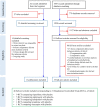Impact of antipsychotics in children and adolescents with autism spectrum disorder: a systematic review and meta-analysis
- PMID: 33494757
- PMCID: PMC7831175
- DOI: 10.1186/s12955-021-01669-0
Impact of antipsychotics in children and adolescents with autism spectrum disorder: a systematic review and meta-analysis
Abstract
Background: The net health benefit of using antipsychotics in children and adolescents with ASD is unclear. This review was performed to provide the evidence necessary to inform the Italian national guidelines for the management of ASD.
Methods: We performed a systematic review of randomized controlled trials (RCTs) comparing antipsychotics versus placebo for the treatment of ASD in children and adolescents. For efficacy, acceptability and safety we considered outcomes evaluated by the guideline panel critical and important for decision-making. Continuous outcomes were analyzed by using standardized mean difference (SMD), and dichotomous outcomes by calculating the risk ratio (RR), with their 95% confidence interval (95% CI). Data were analyzed using a random effects model. We used the Cochrane tool to assess risk of bias of included studies. Certainty in the evidence of effects was assessed according to the GRADE approach.
Results: We included 21 RCTs with 1,309 participants, comparing antipsychotics to placebo. Antipsychotics were found effective on "restricted and repetitive interests and behaviors" (SMD - 0.21, 95% CI - 0.35 to - 0.07, moderate certainty), "hyperactivity, inattention, oppositional, disruptive behavior" (SMD - 0.67, 95% CI - 0.92 to - 0.42, moderate certainty), "social communication, social interaction" (SMD - 0.38, 95% CI - 0.59 to - 0.16, moderate certainty), "emotional dysregulation/irritability" (SMD - 0.71, 95% CI - 0.98 to - 0.43, low certainty), "global functioning, global improvement" (SMD - 0.64, 95% CI - 0.96 to - 0.33, low certainty), "obsessions, compulsions" (SMD - 0.30, 95% CI - 0.55 to - 0.06, moderate certainty). Antipsychotics were not effective on "self-harm" (SMD - 0.14, 95% CI - 0.58 to 0.30, very low certainty), "anxiety" (SMD - 0.38, 95% CI - 0.82 to 0.07, very low certainty). Antipsychotics were more acceptable in terms of dropout due to any cause (RR 0.61, 95% CI 0.48 to 0.78, moderate certainty), but were less safe in terms of patients experiencing adverse events (RR 1.19, 95% CI 1.07 to 1.32, moderate certainty), and serious adverse events (RR 1.07, 95% CI 0.48 to 2.43, low certainty).
Conclusions: Our systematic review and meta-analysis found antipsychotics for children and adolescents with ASD more efficacious than placebo in reducing stereotypies, hyperactivity, irritability and obsessions, compulsions, and in increasing social communication and global functioning. Antipsychotics were also found to be more acceptable, but less safe than placebo.
Keywords: Adolescents; Antipsychotics; Autism spectrum disorder; Children; D2 blockers; Guidelines; Meta-analysis; Systematic review.
Conflict of interest statement
The authors declare that they have no competing interests.
References
-
- American Psychiatric Association: Diagnostic and Statistical Manual of Mental Disorders. Diagnostic and Statistical Manual of Mental Disorders, Fifth Edition. Arlington, VA: American Psychiatric Association, 2013
-
- Istituto Superiore di Sanità. Giornata mondiale della Consapevolezza dell’Autismo: in Italia un bimbo ogni 77. 2019. Available at: https://www.iss.it/?p=3421. Accessed 31 Dec 2019.
-
- Christensen DL, Braun KVN, Baio J, Bilder D, Charles J, Constantino JN, et al. Prevalence and characteristics of Autism Spectrum Disorder among children aged 8 years - autism and developmental disabilities monitoring network, 11 sites, United States. MMWR Surveill Summ. 2012;65(13):1–23. doi: 10.15585/mmwr.ss6513a1. - DOI - PMC - PubMed
Publication types
MeSH terms
Substances
LinkOut - more resources
Full Text Sources
Other Literature Sources
Medical


